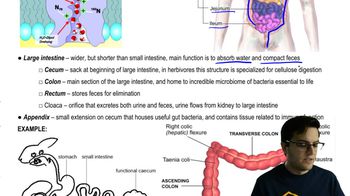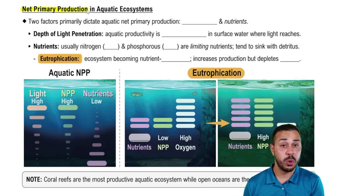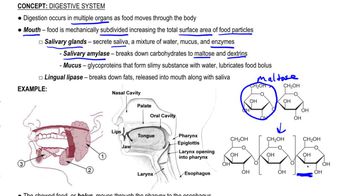Table of contents
- 1. Introduction to Biology2h 42m
- 2. Chemistry3h 40m
- 3. Water1h 26m
- 4. Biomolecules2h 23m
- 5. Cell Components2h 26m
- 6. The Membrane2h 31m
- 7. Energy and Metabolism2h 0m
- 8. Respiration2h 40m
- 9. Photosynthesis2h 49m
- 10. Cell Signaling59m
- 11. Cell Division2h 47m
- 12. Meiosis2h 0m
- 13. Mendelian Genetics4h 44m
- Introduction to Mendel's Experiments7m
- Genotype vs. Phenotype17m
- Punnett Squares13m
- Mendel's Experiments26m
- Mendel's Laws18m
- Monohybrid Crosses19m
- Test Crosses14m
- Dihybrid Crosses20m
- Punnett Square Probability26m
- Incomplete Dominance vs. Codominance20m
- Epistasis7m
- Non-Mendelian Genetics12m
- Pedigrees6m
- Autosomal Inheritance21m
- Sex-Linked Inheritance43m
- X-Inactivation9m
- 14. DNA Synthesis2h 27m
- 15. Gene Expression3h 20m
- 16. Regulation of Expression3h 31m
- Introduction to Regulation of Gene Expression13m
- Prokaryotic Gene Regulation via Operons27m
- The Lac Operon21m
- Glucose's Impact on Lac Operon25m
- The Trp Operon20m
- Review of the Lac Operon & Trp Operon11m
- Introduction to Eukaryotic Gene Regulation9m
- Eukaryotic Chromatin Modifications16m
- Eukaryotic Transcriptional Control22m
- Eukaryotic Post-Transcriptional Regulation28m
- Eukaryotic Post-Translational Regulation13m
- 17. Viruses37m
- 18. Biotechnology2h 58m
- 19. Genomics17m
- 20. Development1h 5m
- 21. Evolution3h 1m
- 22. Evolution of Populations3h 52m
- 23. Speciation1h 37m
- 24. History of Life on Earth2h 6m
- 25. Phylogeny2h 31m
- 26. Prokaryotes4h 59m
- 27. Protists1h 12m
- 28. Plants1h 22m
- 29. Fungi36m
- 30. Overview of Animals34m
- 31. Invertebrates1h 2m
- 32. Vertebrates50m
- 33. Plant Anatomy1h 3m
- 34. Vascular Plant Transport1h 2m
- 35. Soil37m
- 36. Plant Reproduction47m
- 37. Plant Sensation and Response1h 9m
- 38. Animal Form and Function1h 19m
- 39. Digestive System1h 10m
- 40. Circulatory System1h 57m
- 41. Immune System1h 12m
- 42. Osmoregulation and Excretion50m
- 43. Endocrine System1h 4m
- 44. Animal Reproduction1h 2m
- 45. Nervous System1h 55m
- 46. Sensory Systems46m
- 47. Muscle Systems23m
- 48. Ecology3h 11m
- Introduction to Ecology20m
- Biogeography14m
- Earth's Climate Patterns50m
- Introduction to Terrestrial Biomes10m
- Terrestrial Biomes: Near Equator13m
- Terrestrial Biomes: Temperate Regions10m
- Terrestrial Biomes: Northern Regions15m
- Introduction to Aquatic Biomes27m
- Freshwater Aquatic Biomes14m
- Marine Aquatic Biomes13m
- 49. Animal Behavior28m
- 50. Population Ecology3h 41m
- Introduction to Population Ecology28m
- Population Sampling Methods23m
- Life History12m
- Population Demography17m
- Factors Limiting Population Growth14m
- Introduction to Population Growth Models22m
- Linear Population Growth6m
- Exponential Population Growth29m
- Logistic Population Growth32m
- r/K Selection10m
- The Human Population22m
- 51. Community Ecology2h 46m
- Introduction to Community Ecology2m
- Introduction to Community Interactions9m
- Community Interactions: Competition (-/-)38m
- Community Interactions: Exploitation (+/-)23m
- Community Interactions: Mutualism (+/+) & Commensalism (+/0)9m
- Community Structure35m
- Community Dynamics26m
- Geographic Impact on Communities21m
- 52. Ecosystems2h 36m
- 53. Conservation Biology24m
39. Digestive System
Digestion
Problem 3`
Textbook Question
Which of the following organs is incorrectly paired with its function?
a. Stomach—protein digestion
b. Large intestine—bile production
c. Small intestine—nutrient absorption
d. Pancreas—enzyme production
 Verified step by step guidance
Verified step by step guidance1
Identify the primary function of each organ listed in the options.
Option a: The stomach is primarily responsible for the digestion of proteins. It secretes gastric juices, including pepsin, which breaks down proteins into smaller peptides.
Option b: The large intestine is mainly involved in water absorption and the formation of feces. It does not produce bile; bile is produced by the liver.
Option c: The small intestine is the main site for nutrient absorption. It absorbs nutrients from digested food into the bloodstream.
Option d: The pancreas produces enzymes that aid in the digestion of carbohydrates, proteins, and fats. It also produces insulin and glucagon for blood sugar regulation.
 Verified video answer for a similar problem:
Verified video answer for a similar problem:This video solution was recommended by our tutors as helpful for the problem above
Video duration:
2mPlay a video:
Was this helpful?
Key Concepts
Here are the essential concepts you must grasp in order to answer the question correctly.
Digestive System Functions
The digestive system is responsible for breaking down food into nutrients, which the body uses for energy, growth, and cell repair. Each organ within the system has specific functions, such as the stomach for protein digestion, the small intestine for nutrient absorption, and the pancreas for enzyme production. Understanding these functions is crucial for identifying any incorrect pairings.
Recommended video:
Guided course

Digestion and Digestive Tracts
Role of the Large Intestine
The large intestine primarily absorbs water and electrolytes from indigestible food matter and compacts waste into feces. It does not produce bile; bile is produced by the liver and stored in the gallbladder. Recognizing the large intestine's role helps in identifying the incorrect pairing in the question.
Recommended video:
Guided course

Large Intestine
Bile Production
Bile is a digestive fluid produced by the liver and stored in the gallbladder, not the large intestine. It aids in the digestion and absorption of fats in the small intestine. Understanding where bile is produced and its function is essential for correctly answering questions about digestive organ functions.
Recommended video:
Guided course

Primary Production in Aquatic Ecosystems
Related Videos
Related Practice














![Anatomy and Physiology of the Large Intestine [Colon]](https://img.youtube.com/vi/F4W2DLIKXww/mqdefault.jpg)




![IGCSE BIOLOGY REVISION - [Syllabus 7.5] Absorption](https://img.youtube.com/vi/TEOB94oBZN4/mqdefault.jpg)


























